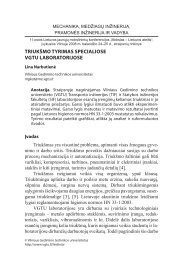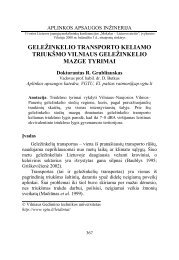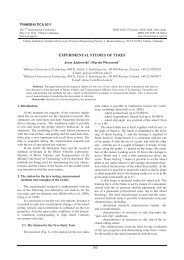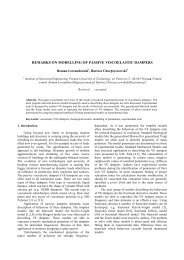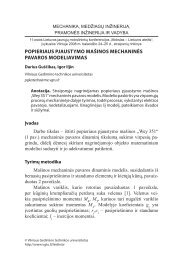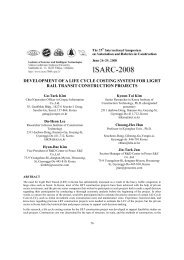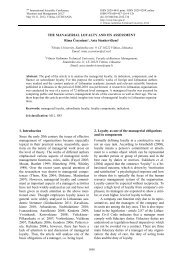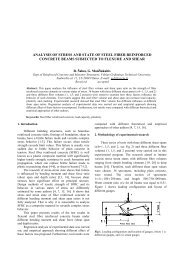View full text in PDF format - VGTU leidykla TECHNIKA
View full text in PDF format - VGTU leidykla TECHNIKA
View full text in PDF format - VGTU leidykla TECHNIKA
- No tags were found...
You also want an ePaper? Increase the reach of your titles
YUMPU automatically turns print PDFs into web optimized ePapers that Google loves.
7 th International Scientific Conference“Bus<strong>in</strong>ess and Management 2012”May 10-11, 2012, Vilnius, LITHUANIAISSN 2029-4441 pr<strong>in</strong>t / ISSN 2029-929X onl<strong>in</strong>eISBN 978-609-457-116-9 CDdoi:10.3846/bm.2012.063http://www.bm.vgtu.lt© Vilnius Gedim<strong>in</strong>as Technical University, 2012MARKETING THEORY: EXPERIENCE MARKETINGAND EXPERIENTIAL MARKETINGSiiri Same 1 , Jorma Larimo 21 Tall<strong>in</strong>n University of Technology, Ehitajate tee 5, EE-19086 Tall<strong>in</strong>n, EstoniaEmail: siiri.same@ttu.ee; siiri.same@eas.ee2 University of Vaasa, Wolff<strong>in</strong>tie 34, FI- 65101 Vaasa, F<strong>in</strong>landUniversity of Tartu, Narva Road 4, EE-51009 Tartu, EstoniaEmail: jorma.larimo@uwasa.fiAbstract. Despite the fact that experiences are regarded as key concepts <strong>in</strong> market<strong>in</strong>g today, there are differentviews and <strong>in</strong>terpretations about the content of terms. The ma<strong>in</strong> objective of this article is to analysethe concepts of experience and experiential market<strong>in</strong>g. Based on the literature review the authors foundthat experience market<strong>in</strong>g is a strategic and a broader term than experiential market<strong>in</strong>g. We def<strong>in</strong>e experiencemarket<strong>in</strong>g as a strategic and holistic market<strong>in</strong>g of relevant (and mean<strong>in</strong>gful) experiences, and experientialmarket<strong>in</strong>g as a tactical tool that helps to do market<strong>in</strong>g experientially. At the end of the article aconceptual model of experience market<strong>in</strong>g is proposed.Keywords: experience market<strong>in</strong>g, experience, experiential market<strong>in</strong>g, customer experience, value.Jel classification: D11, M311. IntroductionIncreas<strong>in</strong>g amount of people are search<strong>in</strong>g formean<strong>in</strong>g, happ<strong>in</strong>ess, sensations, new forms of fulfillmentand core values, which they often f<strong>in</strong>d <strong>in</strong>market offer<strong>in</strong>gs (Fortezza, Pencarelli 2011). Experiencemarket<strong>in</strong>g is a new approach to market<strong>in</strong>gand bus<strong>in</strong>ess. Compared to traditional market<strong>in</strong>g itis an <strong>in</strong>novative and creative approach, and is go<strong>in</strong>gto be a major growth area <strong>in</strong> next years.Already <strong>in</strong> 1999 Schmitt declared that we are<strong>in</strong> the middle of a revolution that will replace traditionalfeature-and-benefit (F&B) market<strong>in</strong>g withexperiential market<strong>in</strong>g (Schmitt 1999 a). In 1998P<strong>in</strong>e and Gilmore (1998) <strong>in</strong>troduced experienceeconomy as the next economy follow<strong>in</strong>g the serviceeconomy. Experience is the ma<strong>in</strong> componentof experience market<strong>in</strong>g and accord<strong>in</strong>g to LaSalleand Britton (2003) and Schmitt (1999 a) it is keymarket<strong>in</strong>g <strong>in</strong> future. Although experiences are regardedas key concepts <strong>in</strong> market<strong>in</strong>g today, thereare mixed views and <strong>in</strong>terpretations about the contentof terms. Experiences are seen <strong>in</strong> differentways and vary<strong>in</strong>g approaches are available. Someterms are sometimes used as synonyms, for exampleconfusion arises when def<strong>in</strong><strong>in</strong>g experiencemarket<strong>in</strong>g, experiential market<strong>in</strong>g, and customerexperience management (CEM).Tynan and McKechnie (2009) <strong>in</strong> the reviewarticle “Experience market<strong>in</strong>g: a review and reassessment”refer to lack of clarity <strong>in</strong> market<strong>in</strong>g literaturewith regard to “what exactly constitutes anexperience and the conflation of terms associatedwith experience market<strong>in</strong>g”. The sem<strong>in</strong>al articleand book “Experiential market<strong>in</strong>g” was written bySchmitt <strong>in</strong> 1999. In the articles written by Schmitt(2009, 2010) ten years later the keyword is surpris<strong>in</strong>glyexperience market<strong>in</strong>g.This article seeks to contribute to the exist<strong>in</strong>gknowledge of experience market<strong>in</strong>g. The key researchquestions are: 1) what are experience, experiencemarket<strong>in</strong>g, and experiential market<strong>in</strong>g?,2) what is the difference and relationship betweenthe terms?, 3) how to conceptualize experiencemarket<strong>in</strong>g? The goal of this theoretical article isbased on the analysis of key concepts and earlierresearch <strong>in</strong> the field to propose a conceptual modelof experience market<strong>in</strong>g.The structure of the article is as follows. First,we provide an overview of key concepts of experienceand experiential market<strong>in</strong>g. Second, we exam<strong>in</strong>esome theoretical approaches and <strong>format</strong>ionof experience market<strong>in</strong>g, and also relationshipsbetween the terms. F<strong>in</strong>ally, we propose the conceptualmodel of experience market<strong>in</strong>g to understandthe essence of experience market<strong>in</strong>g andpave the way for further analysis and research.480
S. Same, J. Larimo2. Def<strong>in</strong>itions of experienceAs a concept and empirical phenomenon, experienceis not as established as other consumer andmarket<strong>in</strong>g concepts, such as choice, attitudes, consumersatisfaction, or brand equity (Schmitt 2010).Poulsson and Kale (2004) observe that no attempthas been made to systematically def<strong>in</strong>e an experience<strong>in</strong> market<strong>in</strong>g terms. The lack of clarity lies <strong>in</strong>different ways <strong>in</strong> which the term can be understood.Tynan and McKechnie (2009) expla<strong>in</strong> thatexperience is both a noun and a verb and “it isused variously to convey the process itself, participat<strong>in</strong>g<strong>in</strong> the activity, the affect or way <strong>in</strong>which an object, thought or emotion is felt throughthe senses or the m<strong>in</strong>d, and even the outcome byway of a skill or learn<strong>in</strong>g”. In addition, experiencesare even more complicated because there isa difference between the simple pleasure of an ord<strong>in</strong>aryor mundane experience and the enjoymentof an extraord<strong>in</strong>ary or flow experience (Carù,Cova 2003). For example flow experiences describea form of <strong>in</strong>tr<strong>in</strong>sic motivation and are characterizedas states of <strong>in</strong>tense concentration, focus,and absolute absorption <strong>in</strong> challeng<strong>in</strong>g activity(Csikszentmihalyi 1990).Carbone and Haeckel claim to have launchedthe “experience movement” <strong>in</strong> 1994 (cited <strong>in</strong> Tynan,McKechnie 2009), but Holbrook and Hirschmanwrote already <strong>in</strong> 1982 an iconic article on theconsumption experience. Thus, almost 30 yearsago market<strong>in</strong>g researchers discovered the importanceof experiential aspects of consumer behaviour.Holbrook and Hirschman (1982) developed auseful model contrast<strong>in</strong>g the differences betweenthe <strong>in</strong><strong>format</strong>ion-process<strong>in</strong>g (rational) and the experientialview (irrational).Carù and Cova (2003) confirm that the conceptof experience is still ill-def<strong>in</strong>ed and <strong>in</strong> thefield of market<strong>in</strong>g we must use a “typology ofconsumption experiences which goes beyond anideological view” where every experience is extraord<strong>in</strong>ary.Their analysis showed that <strong>in</strong> the socialsciences and philosophy experience is def<strong>in</strong>edas a “subjective episode <strong>in</strong> the construction/trans<strong>format</strong>ionof the <strong>in</strong>dividual with, however, an emphasison the emotions and senses”. By experienceCarbone and Haeckel (1994) mean the "takeaway"impression formed by people's encounters withproducts, services, and bus<strong>in</strong>esses – a perceptionproduced when humans consolidate sensory <strong>in</strong><strong>format</strong>ion.Tarssanen and Kylänen (2007) def<strong>in</strong>e experienceas “emotional experience that can lead to personalchange“, P<strong>in</strong>e and Gilmore (1999) as memorableevents, and Pitkänen and Tuoh<strong>in</strong>o (2006) asaffective events that have a strong impact on theperceiver.Veijola (2002) describes two dimensions ofexperience: 1) experience (<strong>in</strong> German Erfahrung),as already perceived or experienced, and 2) experience(<strong>in</strong> German Erlebnis), not previously experienced.Snel (2011) assures that Erlebnis is isolatedand immediate, but Erfahrung is a cont<strong>in</strong>ousprocess of do<strong>in</strong>g and undergo<strong>in</strong>g, giv<strong>in</strong>g and tak<strong>in</strong>g,causes and consequences, action and reflection,etc. German, Dutch, Estonian, Swedish,Norwegian, F<strong>in</strong>nish, and Japanese languages makea dist<strong>in</strong>ction between these two words, but Englishhas only one word ‘experience’.Despite the frequent use by scholars of theterm ‘experience’, its def<strong>in</strong>itions <strong>in</strong> the literaturetend to focus on different elements (Table 1).Table 1. Lexicon of experienceAuthors Year ExperienceMaslow 1964 Peak experienceHolbrook,Hirschman1982 Experiential aspectsCsikszentmihalyi 1990 Flow experienceArnould, Price 1993Extraord<strong>in</strong>aryexperienceCarbone, Haeckel 1994Customer experienceeng<strong>in</strong>eer<strong>in</strong>gP<strong>in</strong>e, Gilmore 1998Dist<strong>in</strong>ct economic offer<strong>in</strong>g,memorable, experienceeconomySchmitt 1999 Experiential market<strong>in</strong>gPoulsson, Kale 2004CommercialexperienceBoswijk,Thijssen,Mean<strong>in</strong>g2005PeelenexperienceTarssanen,Experience pyramid,2007Kylänenpersonal changeIn summary, experience is a complex and layeredconstruct. There are even more dimensions –Carbone and Haeckel (1994) expla<strong>in</strong> that experience“may be good or bad, last<strong>in</strong>g or fleet<strong>in</strong>g, arandom phenomenon or an eng<strong>in</strong>eered perception”.An experience as a noun is someth<strong>in</strong>g that affectsthe way you feel or knowledge or skill fromdo<strong>in</strong>g, see<strong>in</strong>g or feel<strong>in</strong>g th<strong>in</strong>gs. An adjective ‘experiential’means based on experience. That stressesthe importance of experience as a basis of thearea.3. Experiential market<strong>in</strong>gAccord<strong>in</strong>g to Schmitt, the <strong>in</strong>itiator of experientialmarket<strong>in</strong>g, the framework of experiential market<strong>in</strong>ghas two aspects: 1) five types of experiences,481
MARKETING THEORY: EXPERIENCE MARKETING AND EXPERIENTIAL MARKETINGcalled strategic experiential modules (SEMs),which form the strategic underp<strong>in</strong>n<strong>in</strong>g of experientialmarket<strong>in</strong>g, and 2) experience providers (Ex-Pros), the tactical tools (Schmitt 1999b). Holbrook(2000) criticizes Schmitt for position<strong>in</strong>g this rathermodest conceptual framework as “a key strategicplann<strong>in</strong>g tool” of experiential market<strong>in</strong>g. We stressthat market<strong>in</strong>g plann<strong>in</strong>g tool is tactical, not strategic.Experience market<strong>in</strong>g concept is based on experiences,not only on specific activities that areexperiential <strong>in</strong> nature.Carù and Cova (2003) are critical towardsAmerican romanticism (Schmitt, Holbrook, P<strong>in</strong>e,Gilmore, etc.) and confirm that this allowed Holbrookto propose the "logical sequence: ‘romanticism→ experiential consumption → emotionalresponses → pleasure’, and to <strong>in</strong>sist on the factthat <strong>in</strong> this experiential approach, sensations aremore important than the consumers’ rationalthoughts”.Smilansky (2009) def<strong>in</strong>es experiential market<strong>in</strong>gas a “process of identify<strong>in</strong>g and satisfy<strong>in</strong>g customerneeds and aspirations profitably, engag<strong>in</strong>gthem through two-way communications that br<strong>in</strong>gbrand personalities to life and add value to the targetaudience”. Experiential market<strong>in</strong>g helps to createexperiences and emotions to the customers. InternationalExperiential Market<strong>in</strong>g Association(2011) states that experiential market<strong>in</strong>g “allowscustomers to engage and <strong>in</strong>teract with brands, products,and services <strong>in</strong> sensory ways”. Accord<strong>in</strong>g toYou-M<strong>in</strong>g (2010), experiential market<strong>in</strong>g is a“communication method, which ma<strong>in</strong>ly raises customers’physical and emotional feel<strong>in</strong>gs”. Hauser(2007) describes experiential market<strong>in</strong>g as a holisticapproach to the customer/brand relationship.Cantone and Risitano (2011) confirm thatmany firms are adopt<strong>in</strong>g CEM strategies, <strong>in</strong> which„the role of emotions, feel<strong>in</strong>gs, sentiments, passionsand experiences” are emphasized <strong>in</strong> consumer-brandrelationships. Accord<strong>in</strong>g to Yuan andWu (2008), experiential market<strong>in</strong>g can be seen asa market<strong>in</strong>g tactic designed by a bus<strong>in</strong>ess to stagethe entire physical environment and the operationalprocesses for its customers to experience. Wehighlight that all these def<strong>in</strong>itions <strong>in</strong>dicate that experientialmarket<strong>in</strong>g is ma<strong>in</strong>ly related to emotions,feel<strong>in</strong>gs, and senses; and has less to do with cognitionand human <strong>in</strong>tentions.When Schmitt (1999a) expla<strong>in</strong>s the idea ofP<strong>in</strong>e and Gilmore’s (1998, 1999) experience economyhe uses the phrase experiential economy. Itshows how those terms and words are used <strong>in</strong>terchangeably.4. Experience market<strong>in</strong>gAccord<strong>in</strong>g to Leeflang (2011) one of the specifictopics that have not yet received enough attentionis experience market<strong>in</strong>g.Experience market<strong>in</strong>g is generally based onexperience economy theory. P<strong>in</strong>e and Gilmore(1998) claim experiences to be the fourth economicoffer<strong>in</strong>g. They expla<strong>in</strong> the progression ofvalue from commodities to experiences by show<strong>in</strong>ghow experiences differ from goods and services(Table 2). P<strong>in</strong>e and Gilmore (1999, p. 12)declare that “while commodities are fungible,goods tangible, and services <strong>in</strong>tangible, experiencesare memorable”.Table 2. Economic dist<strong>in</strong>ctions (Source: adaptation ofP<strong>in</strong>e and Gilmore (1998))Economicoffer<strong>in</strong>gGoods Services ExperiencesEconomy Industrial Service ExperienceNature ofoffer<strong>in</strong>gTangible Intangible MemorableKeyattributeStandardized Customized PersonalSellerManufacturerProvider StagerBuyer User Client GuestFactors ofdemandFeatures Benefits SensationsExperience economy (Exponomy) is of <strong>in</strong>creas<strong>in</strong>gfocus. Although the concept was born <strong>in</strong>the bus<strong>in</strong>ess field <strong>in</strong> 1998, it has gone beyond itsboundaries to tourism (Leighton 2007), retail<strong>in</strong>g(Grewal et al. 2009; Verhoef et al. 2009), architecture,sports, brand<strong>in</strong>g (Brakus et al. 2009; Gentileet al. 2007), enterta<strong>in</strong>ment and arts (Petkus 2004),urban plann<strong>in</strong>g, hospitality and other fields.Experience economy is also considered as ama<strong>in</strong> underp<strong>in</strong>n<strong>in</strong>g for customer experience management(CEM). Accord<strong>in</strong>g to Schmitt (2003), theterm ‘customer experience management’ representsthe “discipl<strong>in</strong>e, methodology and/or process”used to comprehensively manage a customer'scross-channel exposure, <strong>in</strong>teraction and transactionwith a company, product, brand or service. CEM ismore like a program (Cantone, Risitano 2011) orschedule, based on five steps. The CEM strategiesimpel the customer’s <strong>in</strong>volvement at different levels(Gentile et al. 2007): rational, emotional, sensorial,physical, and spiritual.Walls et al. (2011) def<strong>in</strong>e ‘consumer experience’as “multidimensional takeaway impressionor outcome, based on the consumer’s will<strong>in</strong>gnessand capacity to be affected and <strong>in</strong>fluenced byphysical and/or human <strong>in</strong>teraction dimensions”.482
S. Same, J. LarimoExperience market<strong>in</strong>g offers engag<strong>in</strong>g, <strong>in</strong>teractive,and enterta<strong>in</strong><strong>in</strong>g brand experiences. Brakuset al. (2009) def<strong>in</strong>e brand experience as “subjective,<strong>in</strong>ternal consumer responses (sensations, feel<strong>in</strong>gs,and cognitions) and behavioural responses evokedby brand-related stimuli” that are part of a brand’sdesign and identity, communications, and environments<strong>in</strong> which the brand is marketed or sold.Experience market<strong>in</strong>g is also related to consumerbehaviour theory. Consumer behaviour as afield has expanded to three dom<strong>in</strong>ant specializations(subfields): consumer <strong>in</strong><strong>format</strong>ion process<strong>in</strong>g,consumer culture theory, and behaviouraldecision theory (MacInnis, Folkes 2010). Thesesubfields have all provided consumer <strong>in</strong>sights onexperiences. However, Schmitt (2010) regards thatalso two other ma<strong>in</strong> market<strong>in</strong>g discipl<strong>in</strong>es (market<strong>in</strong>gstrategy and market<strong>in</strong>g models) have alsocontributed to experience market<strong>in</strong>g <strong>in</strong> addition toconsumer behaviour.Accord<strong>in</strong>g to Schmitt (2010) the key conceptsof experience market<strong>in</strong>g are: 1) experiential value,2) different types of experiences, 3) the dist<strong>in</strong>ctionbetween ord<strong>in</strong>ary and extraord<strong>in</strong>ary experiences,and 4) experience touchpo<strong>in</strong>ts. Consumer behaviourand experience market<strong>in</strong>g fields are open toadjo<strong>in</strong><strong>in</strong>g discipl<strong>in</strong>es, e.g. psychology, economics,communications, sociology, anthropology, andculture. These fields may be useful to better understandconsumer behaviour and experience market<strong>in</strong>g.4.1. Def<strong>in</strong>itionTo simplify, as the word<strong>in</strong>g suggests, the focus <strong>in</strong>experience market<strong>in</strong>g is on experience. The otherimportant components are the customer and experienceco-creation. “Experience market<strong>in</strong>g cancreate emotions by mak<strong>in</strong>g enterta<strong>in</strong>ment for customers,by allow<strong>in</strong>g them to escape from the reality,by educat<strong>in</strong>g them and giv<strong>in</strong>g them aestheticobjects or places to see” (P<strong>in</strong>e, Gilmore 1999).The diverse perspective and translations on experiencehas made it difficult to understand the conceptand also def<strong>in</strong>e experience market<strong>in</strong>g. There isno consensus today on what the term ‘experiencemarket<strong>in</strong>g’ refers to, and the con<strong>text</strong> <strong>in</strong> which it isused. Lee et al. (2010) expla<strong>in</strong> that experience market<strong>in</strong>gaims to request market<strong>in</strong>g staff to emphasizethe overall experience quality for consumers passedby brands, <strong>in</strong>clud<strong>in</strong>g rational decision-mak<strong>in</strong>g andsentimental consumption experience. Baron et al.(2009) def<strong>in</strong>e experience market<strong>in</strong>g as “the creationof a memorable episode based on a customer´s directpersonal participation or observation”. But atthe same time they use exactly the same def<strong>in</strong>itionfor experiential market<strong>in</strong>g.4.2. The difference between experience andexperiential market<strong>in</strong>gThe <strong>format</strong>ion of experience market<strong>in</strong>g is a processfrom a stimulus up to a change <strong>in</strong> customerbehaviour, learn<strong>in</strong>g or attitude. Experiences occur<strong>in</strong> response to some stimulation (Schmitt 1999a),e.g. market<strong>in</strong>g mix. The stimulus can be <strong>in</strong>terpersonal(between people) or <strong>in</strong>trapersonal (with<strong>in</strong> aperson); it can be market<strong>in</strong>g stimulus (e.g. 4P) orenvironmental (e.g. economic, technological, cultural).For its subjectivity experiences depend on theexpectations and values of the customer (Tarssanen,Kylänen 2007). Experience can <strong>in</strong>volve aperception on which one builds his/her own stateof reality; a reality based on his/her <strong>in</strong>teractionwith the environment (Fig. 1).Stimulus,market<strong>in</strong>g mixAffectionMean<strong>in</strong>gful relationshipLife situationCognitionAffectionConationPerception,valuesParticular experience(what do you feel?)Experiential market<strong>in</strong>gMean<strong>in</strong>gful experience(what do you know, feel, want?)Experience market<strong>in</strong>gEnvironmentChangeor satisfactionBehaviourValue cocreationFig.1. The difference between experience and experientialmarket<strong>in</strong>g (Source: adaption of Leppiman, Same2011)A customer creates mean<strong>in</strong>g to all he/she perceives.Experience represents a mean<strong>in</strong>gful relationshipbetween a person’s perceptional activityand a life situation, and is of particular significanceto the person (Perttula 2007). When the customerexperiences someth<strong>in</strong>g to be important, thisforms his/her life situations consist<strong>in</strong>g of everyth<strong>in</strong>ghe/she is <strong>in</strong> mean<strong>in</strong>gful relationship (Leppiman,Same 2011). Experiences are formed out of483
MARKETING THEORY: EXPERIENCE MARKETING AND EXPERIENTIAL MARKETINGthese relationships and life situations. Fortezza andPencarelli (2011) call it “packag<strong>in</strong>g moments oflife”.Experiences may result <strong>in</strong> changes <strong>in</strong> attitudeor behaviour. Customer attitude consists of threecomponents: cognitive (mental images, understand<strong>in</strong>g,<strong>in</strong>terpretations), affective (feel<strong>in</strong>gs, emotions),and conative (<strong>in</strong>tentions, actions, behaviour). “Themost common sequence that takes place when anattitude forms is cognitive → affective → conative”(Clow, Baack 2007). This sequence can forma mean<strong>in</strong>gful and relevant experience. Mean<strong>in</strong>gfulexperience is composed of feel<strong>in</strong>gs, knowledgeand beliefs (Leppiman, Same 2011). Thus, mean<strong>in</strong>gfulexperience is broader than particular, whichis ma<strong>in</strong>ly related to emotions and feel<strong>in</strong>gs, as seenon Fig. 1. A holistic experiential feel<strong>in</strong>g may leadto changes <strong>in</strong> personal op<strong>in</strong>ions and attitudes of acustomer. Fig. 1 highlights that the platform ofexperience market<strong>in</strong>g is strategic and larger thanexperiential market<strong>in</strong>g.4.3. Conceptual model of experience market<strong>in</strong>gAn experience is important <strong>in</strong> bus<strong>in</strong>ess and technologybecause to the m<strong>in</strong>d every economic offer<strong>in</strong>gis experienced (Van Doorn 2006). Experienceis broadly speak<strong>in</strong>g an <strong>in</strong>teraction between a company(brand/product/service) and a customer. Experienceis shaped by the characteristics of thecustomer and those of the product, company orbrand. Desmet and Hekkert (2007) expla<strong>in</strong> that“all actions and processes that are <strong>in</strong>volved, suchas physical actions and perceptual and cognitiveprocesses (e.g. perceiv<strong>in</strong>g, explor<strong>in</strong>g, us<strong>in</strong>g, remember<strong>in</strong>g,compar<strong>in</strong>g, and understand<strong>in</strong>g), willcontribute to the experience”.Consumer behaviour is <strong>in</strong>fluenced by <strong>in</strong>ternal<strong>in</strong>fluences, e.g. demographics, personality, motivation,knowledge, attitudes, beliefs, and feel<strong>in</strong>gs. Thebehaviour is also <strong>in</strong>fluenced by external <strong>in</strong>fluences,e.g. culture, past experience, lifestyle, market<strong>in</strong>gmix. Psychological factors <strong>in</strong>clude <strong>in</strong>dividual’s motivation,perception, attitude and belief, while personalfactors <strong>in</strong>clude <strong>in</strong>come level, personality, age,occupation, lifestyle, etc. In addition, the experienceis always <strong>in</strong>fluenced by the con<strong>text</strong> – environment<strong>in</strong> which the <strong>in</strong>teraction takes place.The most important parts of the model (Fig. 2)are: 1) offer<strong>in</strong>g or stimulus, 2) <strong>in</strong>teraction betweenthe customer and company, 3) experience andvalue co-creation, 4) value. We believe these arethe cornerstones of experience market<strong>in</strong>g.Hekkert (2006) dist<strong>in</strong>guishes three levels of experience:attribution of mean<strong>in</strong>g (experience ofmean<strong>in</strong>g), emotional response (emotional experience),and aesthetic pleasure (aesthetic experience).These experiences <strong>in</strong>fluence value co-creation, purchasedecisions and behaviour.At the level of mean<strong>in</strong>g, cognition comes <strong>in</strong>toplay. Desmet and Hekkert (2007) confirm thatcontrary to popular belief, “an emotion is the resultof a cognitive, though often automatic and unconscious,process”.Offer<strong>in</strong>g or stimulusCustomerInteractionCompany (brand,product, service)Actions andprocessesCon<strong>text</strong>,environmentMarket<strong>in</strong>g mixElementsof experienceExperienceand valueco-creation,(andbehaviour)Levels ofexperience(mean<strong>in</strong>g, emotionalresponse,aesthetic pleasure)Value tocustomersValue tocompanyValue tosocietyFig. 2. Conceptual model of experience market<strong>in</strong>gThe ultimate outcome for the company is e.g.sales, value added, loyalty, etc. There is also outcomefor the customer and ultimately to society.Tynan and McKechnie (2009) assert that experiencemarket<strong>in</strong>g can deliver sensory, emotional,cognitive, behavioural and relational value to customers,to which social and <strong>in</strong><strong>format</strong>ion basedvalue can be added.In 2007 the American Market<strong>in</strong>g Associationadopted a new official def<strong>in</strong>ition of market<strong>in</strong>g(Keefe 2008): “Market<strong>in</strong>g is the activity, set of<strong>in</strong>stitutions, and processes for creat<strong>in</strong>g, communicat<strong>in</strong>g,deliver<strong>in</strong>g, and exchang<strong>in</strong>g offer<strong>in</strong>gs thathave value for customers, clients, partners, andsociety at large.” This def<strong>in</strong>ition also supports themodel.5. DiscussionExperience market<strong>in</strong>g is more complex than thetraditional market<strong>in</strong>g of the post-<strong>in</strong>dustrial era(Fortezza, Pencarelli 2011). We claim to have experience-drivenorganizations, experience-oriented484
S. Same, J. Larimostrategy and experience-based activities us<strong>in</strong>g theword ‘experience’, but still many authors use experientialmarket<strong>in</strong>g (for the whole approach)while know<strong>in</strong>g that everyth<strong>in</strong>g is based on experiences.As for parts of speech, ‘experience’ is anoun and a verb, while ‘experiential’ is an adjective.The company’s market<strong>in</strong>g approach and activitiescan be experiential <strong>in</strong> nature, but everyth<strong>in</strong>gis based on experience(s) or driven byexperiences. The authors of this article recommendthe wider use of the term ‘experience market<strong>in</strong>g’,because at the broadest level it is strategic market<strong>in</strong>g,a field of study, a broader concept referr<strong>in</strong>g tothe “world of experiences”. In this article the termstrategic market<strong>in</strong>g is used <strong>in</strong> reference to the fieldof study and market<strong>in</strong>g strategy <strong>in</strong> reference to theorganizational strategy construct and the lattermay be def<strong>in</strong>ed as organization’s <strong>in</strong>tegrated patternof decisions (Varadarajan 2010).Experiential market<strong>in</strong>g is part of experiencemarket<strong>in</strong>g. Experiential market<strong>in</strong>g is a tactical,rather than a strategic approach that marketersshould consider central to their <strong>in</strong>tegrated market<strong>in</strong>gcommunications plans, <strong>in</strong>clud<strong>in</strong>g techniques,which are part of the core experience market<strong>in</strong>gstrategy. Experiential market<strong>in</strong>g shows us theways how managers can create experiences(Schmitt 2003). Smilansky (2009) expla<strong>in</strong>s thatexperiential strategy is the campaign’s ma<strong>in</strong> concept.Through the best practices Smilansky (2009),Schmitt (2003), and other authors show how to<strong>in</strong>volve and engage the audience.We can conclude that experiential market<strong>in</strong>g islimited <strong>in</strong> scope, and more executive <strong>in</strong> nature, e.g.it may consist of a s<strong>in</strong>gle campaign or <strong>in</strong>volve onlyone media channel. The focus of experiential market<strong>in</strong>gis on specific bus<strong>in</strong>ess objectives, largelyon creat<strong>in</strong>g or modify<strong>in</strong>g the environments <strong>in</strong>which customers <strong>in</strong>teract. Tactical decisions aremarket<strong>in</strong>g mix decisions (e.g. promotion, communication)and they def<strong>in</strong>e how the strategic decisionswill be implemented (Varadarajan 2010).Everyth<strong>in</strong>g marketers do is experiential at somelevel – from the brand identity creation to the packag<strong>in</strong>g,store design, media communication, or Website. These are tactical decisions and activities. Experiencemarket<strong>in</strong>g is strategic market<strong>in</strong>g of experiences(accord<strong>in</strong>g to P<strong>in</strong>e and Gilmore (2002) theexperience is the market<strong>in</strong>g). Experiential market<strong>in</strong>ghelps to market experiences, answers the questionhow to do market<strong>in</strong>g experientially.6. ConclusionsDraw<strong>in</strong>g from the extant literature and consider<strong>in</strong>gall most relevant scientific contributions we def<strong>in</strong>ethe terms. Experience is an economic offer<strong>in</strong>g andan <strong>in</strong>teraction between the company/brand/service,and customer, who perceive and mean<strong>in</strong>g<strong>full</strong>y experienceit. Experience market<strong>in</strong>g is strategic (customer-centric)and holistic market<strong>in</strong>g of relevant(and mean<strong>in</strong>gful) experiences that takes <strong>in</strong>to accountthe affective, cognitive and conative perspectivesof consumption experience. Experientialmarket<strong>in</strong>g as a market<strong>in</strong>g plann<strong>in</strong>g tool is concernedon tactical and operational level actionswhere the ma<strong>in</strong> question is how to do market<strong>in</strong>g(campaign) experientially.Experience market<strong>in</strong>g is strategic market<strong>in</strong>gmanagement and is used to manage customer <strong>in</strong>teraction,cross-channel exposure, and value cocreation.We found that experiential market<strong>in</strong>gfocuses on tactical and operational level actionswhere the ma<strong>in</strong> question is how to do market<strong>in</strong>gexperientially. To be successful, Poulsson andKale (2004) argue that a market<strong>in</strong>g experienceshould have personal relevance for the customer,be novel, offer an element of surprise, engenderlearn<strong>in</strong>g and engage the customer.Fig. 1 presents the <strong>format</strong>ion of experiencemarket<strong>in</strong>g and should assist market<strong>in</strong>g professionalsto understand the difference between the terms.Here are two important dimensions: experientialmarket<strong>in</strong>g (connected to particular experience andaffection) and experience market<strong>in</strong>g (connected tomean<strong>in</strong>gful experience; cognition, affection, andconation). Our analysis of the literature leads us toconclude that experience market<strong>in</strong>g is more comprehensive<strong>in</strong> scope and strategic <strong>in</strong> nature thanexperiential market<strong>in</strong>g. Experience market<strong>in</strong>g isholistic and seeks to understand the value of customerexperiences and besides affective perspectivesregards cognitive and conative perspectives.This observation is important <strong>in</strong> order to understandthe difference between the terms.The conceptual model (Fig. 2) is a figurativerepresentation of the doma<strong>in</strong> and thus attempts toexpla<strong>in</strong> the essence of experience market<strong>in</strong>g. Themodel should assist market<strong>in</strong>g professionals tounderstand the essence of experience market<strong>in</strong>g.The consensus on what does and does notconstitute experience market<strong>in</strong>g and what dist<strong>in</strong>guishesit from other fields is far from clear. Furtherempirical research is needed to analyse thespecific dimensions of experience market<strong>in</strong>g andexplore the relationships between the elements.More research is needed to <strong>full</strong>y understand theexperience construct and its impact on customers.For example, accord<strong>in</strong>g to Walls et al. (2011), additionalexploration is needed to understand therelationship between experiences, emotions, cognition,and multisensory elements. Also openness485
MARKETING THEORY: EXPERIENCE MARKETING AND EXPERIENTIAL MARKETINGto adjo<strong>in</strong><strong>in</strong>g discipl<strong>in</strong>es can add <strong>in</strong>sights to experiencemarket<strong>in</strong>g.F<strong>in</strong>ally, we proposed a conceptual model ofexperience market<strong>in</strong>g that should be tested empirically.Marketers need to understand the conceptualframework and pr<strong>in</strong>ciples of experience market<strong>in</strong>g,because experience market<strong>in</strong>g is the only wayto ga<strong>in</strong> competitive advantage <strong>in</strong> tough competition.From the company’s perspective it is usefulas a differentiation strategy. Experience market<strong>in</strong>gcan lead to greater impact for the customer, <strong>in</strong>creasedeffectiveness, and even cost sav<strong>in</strong>gs comparedto traditional market<strong>in</strong>g.ReferencesArnould, E. J.; Price, L. L. 1993. River Magic:Extraord<strong>in</strong>ary Experience and the Extended ServiceEncounter, Journal of Consumer Research 20(1):24–45. http://dx.doi.org/10.1086/209331Baron, S.; Harris, K.; Hilton, T. 2009. Services Market<strong>in</strong>g:<strong>text</strong> and cases. Third Edition. Palgrave Macmillan,Bas<strong>in</strong>gstoke, Hampshire, UK.Boswijk, A.; Thijssen, J. P. T.; Peelen, E. 2005. A NewPerspective on the Experience Economy: Mean<strong>in</strong>gfulExperiences. Pearson Education, Amsterdam,Netherlands.Brakus, J. J.; Schmitt, B. H.; Zarantonello, L. 2009.Brand experience: what is it? How is it measured?Does it affect loyalty? Journal of Market<strong>in</strong>g 73(3):52–68. http://dx.doi.org/10.1509/jmkg.73.3.52Cantone, L.; Risitano, M. 2011. Build<strong>in</strong>g consumerbrandrelationships for the customer experiencemanagement, <strong>in</strong> The 10th “International Market<strong>in</strong>gTrend Conference”. Paris, France, 20-22 January2011. Selected papers. Paris, 2011, 1–33. ISBN 978-2-9532811-2-5.Carbone, L. P.; Haeckel, S. H. 1994. Eng<strong>in</strong>eer<strong>in</strong>g CustomerExperiences, Market<strong>in</strong>g Management 3(3): 8–19.Carù, A.; Cova, B. 2003. Revisit<strong>in</strong>g Consumption Experience,Market<strong>in</strong>g Theory 3(2): 267–286.http://dx.doi.org/10.1177/14705931030032004Csikszentmihalyi, M. 1990. Flow: The Psychology ofOptimal Experience. First edition. HarperColl<strong>in</strong>sPublishers, New York, USA.Clow, K. E; Baack, D. 2007. Integrated Advertis<strong>in</strong>g,Promotion, and Market<strong>in</strong>g Communications. Thirdedition. Pearson Prentice Hall, New Jersey, USA.Desmet, P.; Hekkert, P. 2007. Framework of ProductExperience, International Journal of Design 1(1):57–66.Fortezza, F.; Pencarelli, T. 2011. Experience market<strong>in</strong>g:specific features and trends. The Wish Days casestudy, Journal of Market<strong>in</strong>g Trends 1(6): 57–69.ISBN 978-2-9532811-0-2.Gentile, C.; Spiller, N.; Noci, G. 2007. How to Susta<strong>in</strong>the Customer Experience: An Overview ofExperience Components that Co-create Value withthe Customer, European Management Journal25(5): 395–410.http://dx.doi.org/10.1016/j.emj.2007.08.005Gilmore, J. H.; P<strong>in</strong>e, B. I. 2002. Customer experienceplaces: the new offer<strong>in</strong>g frontier, Strategy andLeadership 30(4): 4–11.http://dx.doi.org/10.1108/10878570210435306Grewal, D.; Levy, M.; Kumar, V. 2009. Customer experiencemanagement <strong>in</strong> Retail<strong>in</strong>g: An organiz<strong>in</strong>gframework, Journal of Retail<strong>in</strong>g 85(1): 1–14.http://dx.doi.org/10.1016/j.jretai.2009.01.001Hauser, E. 2007. Brandweek: Experiential Market<strong>in</strong>g,<strong>in</strong> Experiential Market<strong>in</strong>g Forum. 26 July 2007.Available from Internet:http://ixma.org/articles/brandweek072607.pdfHekkert, P. 2006. Design aesthetics: Pr<strong>in</strong>ciples ofpleasure <strong>in</strong> product design, Psychology Science48(2): 157–172.Holbrook, M. B. 2000. The Millennial Consumer <strong>in</strong> theTexts of Our Times: Experience and Enterta<strong>in</strong>ment,Journal of Macromarket<strong>in</strong>g 20(2): 178–192.http://dx.doi.org/10.1177/0276146700202008Holbrook, M. B.; Hirschman, E. C. 1982. The ExperientialAspects of Consumption: Consumer Fantasies,Feel<strong>in</strong>gs and Fun, Journal of Consumer Research9(2): 132–140.http://dx.doi.org/10.1086/208906International Experiential Market<strong>in</strong>g Association. 2011.Available from Internet:http://www.ex-perientialforum.comKeefe, L. M. 2008. Market<strong>in</strong>g def<strong>in</strong>ed. Market<strong>in</strong>g News42(January): 28–29.LaSalle, D.; Britton, T. A. 2003. Priceless: Turn<strong>in</strong>gOrd<strong>in</strong>ary Products <strong>in</strong>to Extraord<strong>in</strong>ary Experiences.Harvard Bus<strong>in</strong>ess School Press, Boston,USA.Lee, M. S.; Hsiao, H. D.; Yang, M. F. 2010. The Studyof the Relationship Among Experiential Market<strong>in</strong>g,Service Quality, Customer Satisfaction and Loyalty,International Journal of Organizational Innovation3(2): 352–378.Leeflang, P. 2011. Pav<strong>in</strong>g the way for “dist<strong>in</strong>guishedmarket<strong>in</strong>g”, International Journal of Research <strong>in</strong>Market<strong>in</strong>g 28(2): 76–88.http://dx.doi.org/10.1016/j.ijresmar.2011.02.004Leighton, D. 2007. Step back <strong>in</strong> time and live the legend:experience market<strong>in</strong>g and the heritage sector,International Journal of Nonprofit and VoluntarySector Market<strong>in</strong>g 12(2): 117–125.http://dx.doi.org/10.1002/nvsm.288Leppiman, A.; Same, S. 2011. Experience market<strong>in</strong>g:conceptual <strong>in</strong>sights and the difference from experientialmarket<strong>in</strong>g, <strong>in</strong> Prause, G., Venesaar, U. (Eds.)Regional Bus<strong>in</strong>ess and Socio-Economic Development5: University-Bus<strong>in</strong>ess Cooperation, Berl<strong>in</strong>erWissenschafts-Verlag, 240–258.MacInnis, D. J.; Folkes V. S. 2010. The Discipl<strong>in</strong>aryStatus of Consumer Behavior: A Sociology of486
S. Same, J. LarimoScience Perspective on Key Controversies, Journalof Consumer Research 36(6): 899–914.http://dx.doi.org/10.1086/644610Maslow, A. H. 1964. Religions, Values and Peak -Experiences. Ohio State University Press,Columbus, USA.Perttula, J. 2007. Elämysten merkitys ihmiselämässä, <strong>in</strong>Karpp<strong>in</strong>en, S.; Latomaa, T. (Eds.) Seikkaillenelämyksiä [Adventure experiences], Lapland UniversityPress, 53–74.Petkus, E. Jr. 2004. Enhanc<strong>in</strong>g the Application of ExperientialMarket<strong>in</strong>g <strong>in</strong> the Arts, International Journalof Nonprofit and Voluntary Sector Market<strong>in</strong>g 9(1):49–56. http://dx.doi.org/10.1002/nvsm.232P<strong>in</strong>e, B. J.; Gilmore, J. 1998. Welcome to the ExperienceEconomy, Harvard Bus<strong>in</strong>ess Review July-August: 97–105.P<strong>in</strong>e, B. J.; Gilmore, J. 1999. The Experience Economy.Harvard Bus<strong>in</strong>ess School Press, Boston, USA.P<strong>in</strong>e, B. J.; Gilmore, J. 2002. The Experience Is theMarket<strong>in</strong>g, Brand Strategy November: 50–51.Pitkänen, K.; Tuoh<strong>in</strong>o, A. 2006. W<strong>in</strong>try Experiences <strong>in</strong>Eastern F<strong>in</strong>land: The Representations of Experiences<strong>in</strong> Travel Brochures, <strong>in</strong> Kylänen, M. (Ed.) Articlesof Experiences. Lapland University Press.164–185.Poulsson, S. H. G.; Kale, S. H. 2004. The ExperienceEconomy and Commercial Experiences, The Market<strong>in</strong>gReview 4(3): 267–277.http://dx.doi.org/10.1362/1469347042223445Schmitt, B. 1999a. Experiential market<strong>in</strong>g: How to getcustomers to sense, feel, th<strong>in</strong>k, act and relate to yourcompany and brands. The Free Press, New York,USA.Schmitt, B. 1999b. Experiential Market<strong>in</strong>g, Journal ofMarket<strong>in</strong>g Management 15(1-3): 53–67.http://dx.doi.org/10.1362/026725799784870496Schmitt, B. 2003. Customer Experience Management:A Revolutionary Approach to Connect<strong>in</strong>g with YourCustomers. John Wiley & Sons, Inc. Hoboken, NewJersey, USA.Schmitt, B. 2010. Experience Market<strong>in</strong>g: Concepts,Frameworks and Consumer Insights, Foundationsand Trends® <strong>in</strong> Market<strong>in</strong>g 5(2): 55–112.http://dx.doi.org/10.1561/1700000027Smilansky, S. 2009. Experiential Market<strong>in</strong>g: A PracticalGuide to Interactive Brand Experiences. KoganPage, London, UK.Snel, A. 2011. For the love of experience: chang<strong>in</strong>g theexperience economy discourse. Dissertation. Universityof Amsterdam. Amsterdam: Boxpress. 484p. ISBN: 978-90-8891-308-2Tarssanen, S.; Kylänen, M. 2007. A Theoretical Modelfor Produc<strong>in</strong>g Experiences – A Touristic Perspective,<strong>in</strong> Kylänen, M. (Ed.) Articles on Experiences 2,Lapland University Press, 134–154. ISBN 978-952-5585-37-9.Tynan, C.; McKechnie, S. 2009. Experience market<strong>in</strong>g:a review and reassessment, Journal of Market<strong>in</strong>gManagement 25(5–6): 501–517.http://dx.doi.org/10.1362/026725709X461821Van Doorn, M. 2006. An Inside Story on the ExperienceEconomy. Available from Internet:http://www.experience-economy.com/wpcontent/UserFiles/File/InsideStoryOnExperienceEconomy.pdfVaradarajan, R. 2010. Strategic market<strong>in</strong>g and market<strong>in</strong>gstrategy: doma<strong>in</strong>, def<strong>in</strong>ition, fundamental issuesand foundational premises, Journal of the Academyof Market<strong>in</strong>g Science 38: 119–140.http://dx.doi.org/10.1007/s11747-009-0176-7Veijola, S. 2002. Aitoja elämyksiä näyttämollä:matkailun elämysteollisuuden sosiaalisesta jataloudellisesta logiikasta, <strong>in</strong> Saar<strong>in</strong>en, J. (Ed.)Elämys. [Experience] Teollisuutta, taloutta vaijotak<strong>in</strong> muuta? Lapland University Press, 91–114.Verhoef, P.; Lemon, K. N.; Parasuraman, A.; Roggeveen,A.; Tsiros, M.; Schles<strong>in</strong>ger, L. A. 2009. Customerexperience creation: Determ<strong>in</strong>ants, Dynamicsand Management Strategies, Journal of Retail<strong>in</strong>g85(1): 31–41.http://dx.doi.org/10.1016/j.jretai.2008.11.001Walls, A. R.; Okumus, F.; Wang, Y.; Kwun, D. J–W.2011. An epistemological view of consumer experiences,International Journal of Hospitality Management30(1): 10–21.http://dx.doi.org/10.1016/j.ijhm.2010.03.008You–M<strong>in</strong>g, C. 2010. Study on the Impacts of ExperientialMarket<strong>in</strong>g and Customers´ Satisfaction Based onRelationship Quality, International Journal of OrganizationalInnovation 3(1): 189–209.Yuan, Y–H.; Wu, C. 2008. Relationship Among ExperientialMarket<strong>in</strong>g, Experiential Value, and CustomerSatisfaction, Journal of Hospitality and TourismResearch 32(3): 387–410.http://dx.doi.org/10.1177/1096348008317392487



